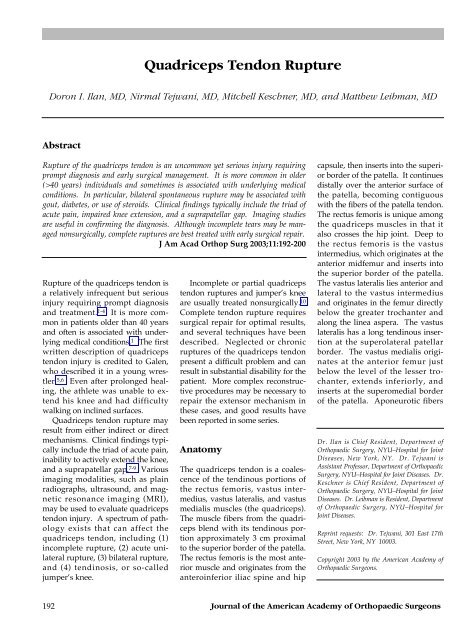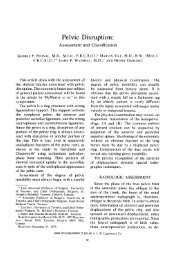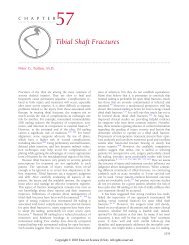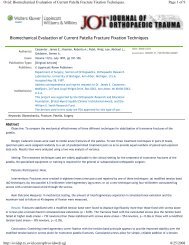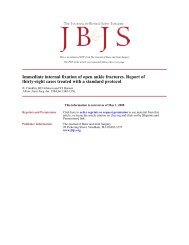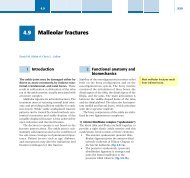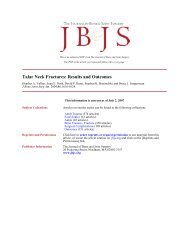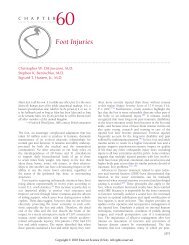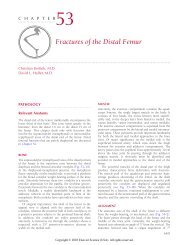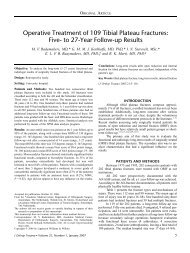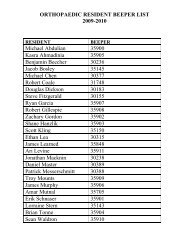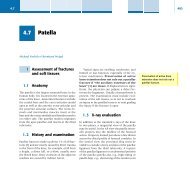Quadriceps Tendon Rupture
Quadriceps Tendon Rupture
Quadriceps Tendon Rupture
You also want an ePaper? Increase the reach of your titles
YUMPU automatically turns print PDFs into web optimized ePapers that Google loves.
<strong>Quadriceps</strong> <strong>Tendon</strong> <strong>Rupture</strong>Doron I. Ilan, MD, Nirmal Tejwani, MD, Mitchell Keschner, MD, and Matthew Leibman, MDAbstract<strong>Rupture</strong> of the quadriceps tendon is an uncommon yet serious injury requiringprompt diagnosis and early surgical management. It is more common in older(>40 years) individuals and sometimes is associated with underlying medicalconditions. In particular, bilateral spontaneous rupture may be associated withgout, diabetes, or use of steroids. Clinical findings typically include the triad ofacute pain, impaired knee extension, and a suprapatellar gap. Imaging studiesare useful in confirming the diagnosis. Although incomplete tears may be managednonsurgically, complete ruptures are best treated with early surgical repair.J Am Acad Orthop Surg 2003;11:192-200<strong>Rupture</strong> of the quadriceps tendon isa relatively infrequent but seriousinjury requiring prompt diagnosisand treatment. 1-4 It is more commonin patients older than 40 yearsand often is associated with underlyingmedical conditions. 1 The firstwritten description of quadricepstendon injury is credited to Galen,who described it in a young wrestler.5,6 Even after prolonged healing,the athlete was unable to extendhis knee and had difficultywalking on inclined surfaces.<strong>Quadriceps</strong> tendon rupture mayresult from either indirect or directmechanisms. Clinical findings typicallyinclude the triad of acute pain,inability to actively extend the knee,and a suprapatellar gap. 7-9 Variousimaging modalities, such as plainradiographs, ultrasound, and magneticresonance imaging (MRI),may be used to evaluate quadricepstendon injury. A spectrum of pathologyexists that can affect thequadriceps tendon, including (1)incomplete rupture, (2) acute unilateralrupture, (3) bilateral rupture,and (4) tendinosis, or so-calledjumper’s knee.Incomplete or partial quadricepstendon ruptures and jumper’s kneeare usually treated nonsurgically. 10Complete tendon rupture requiressurgical repair for optimal results,and several techniques have beendescribed. Neglected or chronicruptures of the quadriceps tendonpresent a difficult problem and canresult in substantial disability for thepatient. More complex reconstructiveprocedures may be necessary torepair the extensor mechanism inthese cases, and good results havebeen reported in some series.AnatomyThe quadriceps tendon is a coalescenceof the tendinous portions ofthe rectus femoris, vastus intermedius,vastus lateralis, and vastusmedialis muscles (the quadriceps).The muscle fibers from the quadricepsblend with its tendinous portionapproximately 3 cm proximalto the superior border of the patella.The rectus femoris is the most anteriormuscle and originates from theanteroinferior iliac spine and hipcapsule, then inserts into the superiorborder of the patella. It continuesdistally over the anterior surface ofthe patella, becoming contiguouswith the fibers of the patella tendon.The rectus femoris is unique amongthe quadriceps muscles in that italso crosses the hip joint. Deep tothe rectus femoris is the vastusintermedius, which originates at theanterior midfemur and inserts intothe superior border of the patella.The vastus lateralis lies anterior andlateral to the vastus intermediusand originates in the femur directlybelow the greater trochanter andalong the linea aspera. The vastuslateralis has a long tendinous insertionat the superolateral patellarborder. The vastus medialis originatesat the anterior femur justbelow the level of the lesser trochanter,extends inferiorly, andinserts at the superomedial borderof the patella. Aponeurotic fibersDr. Ilan is Chief Resident, Department ofOrthopaedic Surgery, NYU–Hospital for JointDiseases, New York, NY. Dr. Tejwani isAssistant Professor, Department of OrthopaedicSurgery, NYU–Hospital for Joint Diseases. Dr.Keschner is Chief Resident, Department ofOrthopaedic Surgery, NYU–Hospital for JointDiseases. Dr. Leibman is Resident, Departmentof Orthopaedic Surgery, NYU–Hospital forJoint Diseases.Reprint requests: Dr. Tejwani, 301 East 17thStreet, New York, NY 10003.Copyright 2003 by the American Academy ofOrthopaedic Surgeons.192Journal of the American Academy of Orthopaedic Surgeons
Doron I. Ilan, MD, et alfrom both the vastus lateralis andmedialis contribute to the lateral andmedial retinacula, respectively. 1,11The articularis genu muscle, ananatomic variant, occasionally contributesfibers to the quadriceps tendon.This muscle arises deep to thevastus intermedius, originating onthe distal anterior femoral diaphysisand inserting into the superior capsule.11 The quadriceps is innervatedby the femoral nerve (L2-4).The four muscles that form thequadriceps unite into one commontendon that incorporates the patella.This tendinous insertion is composedof three distinct planes. Thesuperficial, or anterior, plane containsthe rectus femoris; the second,or middle, plane contains the vastuslateralis and medialis; the third, ordeep, plane contains the vastus intermedius.Deep to these layers isthe synovium, which, when torn,accounts for the large hemarthrosisassociated with quadriceps tendonrupture. 1BiomechanicsThe extensor mechanism is composedof the quadriceps tendon,patella, and patellar tendon. Duringactive knee extension, forces generatedin the quadriceps musclegroup are transferred in a convergentfashion via the patellar tendonand retinacula to the tibial tubercle.The anterior location of the patellaenables it to act as a fulcrum, whichincreases the lever arm of the quadriceps(the distance between thejoint center of rotation and thequadriceps mechanism). 11The transmission of force fromthe quadriceps to the patellar tendonis complex. The relative force ineach tendon varies with the degreeof knee flexion and is modulated bythe ability of the patella to tilt in thesagittal plane. Huberti et al 12 demonstratedincreased forces on thequadriceps tendon in relation to thepatellar tendon at increasing kneeflexion angles. The force in thequadriceps is 30% less than the forcein the patellar tendon at a knee flexionangle of 30°, whereas the forcesare equal at 50° of flexion. At theseflexion angles, the patellofemoralcontact area is located at the distalend of the patella, giving the quadricepstendon a mechanical advantageduring active knee extension. As theknee is flexed beyond 90°, the forcein the quadriceps tendon is 30%greater than the force in the patellartendon. The patellofemoral contactarea shifts proximally with increasingknee flexion, giving the patellartendon a mechanical advantage duringactive knee extension. 12The quadriceps muscle may contractconcentrically (as the muscleshortens) or eccentrically (as themuscle lengthens). Markedly higherforces can be generated during aneccentric contraction, which is whenmost quadriceps muscle and tendoninjuries occur. 13Healing Potential of<strong>Tendon</strong>s<strong>Tendon</strong>s have excellent healingpotential when the torn ends arereasonably approximated. <strong>Tendon</strong>healing begins with an inflammatoryphase characterized by fibroblastmigration. Granulation tissue thenproliferates around the injury site,resulting in randomly oriented collagenfibrils. The density of thefibroblasts increases with time, producingmore collagen. Optimal tendonhealing depends on surgicalapposition and mechanical stabilizationof the tendon ends. Once atendon has been repaired, the suturematerial holds the tendon endstogether, allowing fibroblasts toproduce sufficient amounts of collagento form a tendon callus. Thestrength of the repaired tendondepends on the orientation of thecollagen fibrils and the overall collagenconcentration. Over 3 to 6months, the collagen remodels intoan organized, longitudinal structurethat resembles normal tendon. 14 Incontrast with approximated tears,neglected ruptures with retractionof the proximal portion of the tendonheal with scar tissue, resultingin a lengthened, weakened musculotendinousunit. Poor muscle functionwill result without restorationof normal tendon length. 15 Studiesof tendon healing have indicatedthat early controlled motion andtensile stress applied to a repairedtendon promote earlier organizationand remodeling of collagen fibers,decreased scar tissue, and increasedstrength compared with tendonimmobilization. 14Etiology and Mechanismof InjuryThe normal, healthy quadriceps tendonis a remarkably strong structurethat is extremely resistant to tearingand can bear high loads withoutrupture. 16 Even when the extensormechanism is under loads sufficientto disrupt it, it usually fails at a locationother than the quadriceps tendon.1 In an early study, McMaster 16determined the tensile strength andpoints of rupture of the quadricepstendon in adult rabbits. Values alsowere determined for tendons thathad been crushed or partially severedor that had been ligated in aneffort to obstruct the blood supplyand produce aseptic necrosis. Approximately50% of a tendon’sfibers had to be severed for ruptureto occur, even when subjected toextremely high forces. (Under normalphysiologic stresses, approximately75% of the tendon’s fibersmust be cut before rupture occurs.)<strong>Rupture</strong> was possible under lesserloads at the osteotendinous andmusculotendinous junctions orthrough muscle substance. 1,16 Thesedata suggest that rupture of theVol 11, No 3, May/June 2003 193
<strong>Quadriceps</strong> <strong>Tendon</strong> <strong>Rupture</strong>quadriceps tendon requires a weakenedtendon. The tendons subjectedto vascular insult also rupturedat lesser loads, suggesting that vasculardisturbance may play a role intendon rupture. 16Degenerative changes, such asfatty and cystic degeneration, myxoiddegeneration, microangioblasticdysplasia, decreased collagen, andcalcification, occur within tendonswith age. All of these changes alterthe tendon architecture 1,5,17,18 andmay weaken it. However, quadricepstendon rupture is rare even inolder populations. Thus, other factorsmay make the tendon susceptibleto rupture. In fact, approximatelyone third of patients presentingwith bilateral spontaneous ruptureand 20% of those with unilateralrupture have a systemic medicalcondition that may accelerate degenerationof the healthy tendon. 2,19An array of pathologic conditionscan affect the quadriceps tendon andcontribute to its subsequent ruptureby accelerating fatty degeneration ortendon infiltration or by decreasingcollagen content. Renal disease anduremia can weaken the quadricepsmechanism by causing muscle fiberatrophy. Patients with chronic renalfailure may develop changes withinthe collagen structure itself. 20 Diabeteshas been shown to precipitatevascular changes within the tendon.21 Rheumatoid arthritis causeschronic inflammatory changes resultingin synovitis and diffusefibrosis. 22 Gout can lead to tophaceoussynovitis and fibrinoid necrosisof the tendon. 23 Obesity causesfatty degenerative changes in thetendon. 7 Hyperparathyroidism, systemiclupus erythematosus, osteomalacia,and use of steroids cancause microscopic damage to thevascular supply, altering the normalarchitecture of the tendon and thusincreasing the susceptibility to completerupture. 22,24-26 These findingssuggest that it is necessary to searchfor an underlying medical conditionin any patient presenting with bilateralspontaneous rupture of thequadriceps tendon.Most traumatic ruptures of thequadriceps tendon occur duringattempts to regain balance to avoid afall. The quadriceps muscle rapidlycontracts against the individual’sbody weight (eccentric contraction)while the knee is in a semiflexedposition, placing the quadricepstendon under its greatest tensilestress. 5,16 Although rare, direct traumaor a penetrating injury can resultin disruption of the quadriceps tendon.Clinical PresentationThe diagnosis of quadriceps tendonrupture is largely based on a carefulhistory and physical examination.There is usually the diagnostic triadof pain, inability to actively extendthe knee, and a suprapatellar gap. 7-9The pain is often described as animmediate, intense tearing sensationat the time of rupture. Immobilizationof the extremity in extensionresults in pain relief. On examination,the patient is unable to activelyextend the knee and maintain extensionagainst gravity. Knee aspirationwith an intra-articular anestheticinjection can help relieve the painand allow the physician to moreaccurately assess the extensor mechanism.Active knee flexion typicallyremains intact. A suprapatellar gap,a palpable depression just superiorto the patella, is pathognomonic forquadriceps tendon rupture.Despite these relatively apparentsigns and symptoms, the diagnosisof quadriceps tendon rupture maysometimes initially be missed. Diagnosismay be more difficult when theinjury is accompanied by a hemarthrosis,which can mask the presenceof a suprapatellar gap. As a result,diagnostic failure rates of 10% to 50%have been reported, with delays indiagnosis ranging from days tomonths. 2,6,8,9 When the suprapatellargap is not readily apparent becauseof local fluid accumulation, the signmay be elicited by having the patientactively flex the hip while in thesupine position. This maneuvercauses active shortening of the rectusfemoris muscle, which draws theremaining portions of the quadricepssuperiorly, thus widening the defectat the site of rupture. 8 Clinical evaluationalso can be complicated by thepresence of an intact patellar retinaculumso that the patient retains someability to actively extend the legdespite complete rupture of thequadriceps tendon. However, withan intact retinaculum, the patient hasweak knee extension and considerableextensor lag. Comparison withthe opposite leg is essential to determinewhether there is a rupturedquadriceps tendon with an intactretinaculum. Although a patientwith a complete rupture may be ableto ambulate, the examining physicianshould maintain a high level ofsuspicion for this injury in anyonepresenting with acute onset of painand inability to actively extend theknee in the presence of a fully functionalflexor mechanism.ImagingSeveral kinds of imaging studiescan be useful for evaluation, includingradiography, arthrography,ultrasound, and MRI. Anteroposteriorand lateral radiographsshould be done initially becausethey usually reveal several consistentfindings. In one study in 18patients, 9 radiographs demonstratedobliteration of the quadricepstendon shadow in all 18 knees; asuprapatellar mass in 12; suprapatellarcalcific densities in 12; andan inferiorly displaced patella in 10.Seventeen of 18 knees showed atleast three of the previously mentionedradiographic abnormalities.The suprapatellar mass represents194Journal of the American Academy of Orthopaedic Surgeons
Doron I. Ilan, MD, et alretraction of the ruptured tendon,and the calcific densities may representeither avulsed fragments ofbone or dystrophic calcifications ofthe tendon itself. 9,27Before the advent of MRI, arthrographywas used to confirm thediagnosis of quadriceps tendon rupture.Extravasation of radiopaquematerial occurred at the site of theruptured tendon in patients withquadriceps tendon rupture. However,arthrography has been supplantedby ultrasound and MRI,both of which are less invasive. 27Ultrasound is a highly sensitiveand specific means of assessmentthat delineates the location of therupture and helps differentiate partialfrom complete tears. With completeruptures, free ends of tendonfibers are separated by a hypoechoicto anechoic area representing hematoma.Distraction of the patellaincreases the gap in complete tearsbut not in partial tears (Fig. 1). Ultrasoundalso can be used to assessthe repaired tendon after surgery. 27,28However, its reliability is operatordependent.MRI (Fig. 2) is the most effectivemeans to visualize the injured quadricepstendon, particularly whenextensive hematoma and edemaobscure the effectiveness of otherstudies. 27 MRI consistently andaccurately depicts the injury and itslocation, making it a useful aid insurgical planning. 29,30 Additionally,visualization of other pathologywithin the knee is possible. However,because of its cost, MRI shouldbe reserved for cases in which otherdiagnostic methods have failed. 27,29,30ManagementIncomplete <strong>Rupture</strong>Incomplete tears are usuallymanaged nonsurgically, and treatmentshould commence immediatelyonce a complete tear is ruled out.The patient is initially immobilizedwith the knee in full extension for 6weeks, after which protected rangeof-motionand strengthening exercisesmay be started. The immobilizeris progressively discontinuedwhen the patient achieves goodquadriceps muscle control and isable to straight-leg raise withoutdiscomfort.Traumatic hemarthrosis resultingin knee effusion is common afterquadriceps tendon rupture. Jensenand Graf 31 showed that even smallamounts of effusion decrease quadricepsstrength, thus supporting theneed for aggressive treatment ofknee effusion to promote rehabilitation.Ice, compression, and antiinflammatorymedication can beused, as well as knee aspiration toevacuate the hemarthrosis. Althoughno study has specificallyexamined the benefit of knee aspirationin quadriceps tendon injuries,hematoma aspiration may be of usein reducing pain and promotingrecovery. To avoid difficulty oncethe hematoma has consolidated,aspiration should be done early.<strong>Quadriceps</strong> tendonPatellaFigure 1 Sagittal ultrasound of a complete tear of the quadriceps tendon without (left)and with (right) manual distraction of the patella. Anechoic area (white arrows) representsthe rupture site and hematoma. Note the increased gap with distraction of the patella.This gap would not change in an incomplete tear. (Reproduced with permission fromBianchi S, Zwass A, Abdelwahab IF, Banderali A: Diagnosis of tears of the quadriceps tendonof the knee: Value of sonography. AJR Am J Roentgenol 1994;162:1137-1140.)Acute Unilateral <strong>Rupture</strong>Nonsurgical management ofcomplete quadriceps tendon ruptureyields poor results, includinglong-term disability and weak-Figure 2 Sagittal T1-weighted MRI scandemonstrating complete rupture of thequadriceps tendon (arrow).Vol 11, No 3, May/June 2003 195
<strong>Quadriceps</strong> <strong>Tendon</strong> <strong>Rupture</strong>ness. 17,32 Delaying surgery oftencomplicates the repair process andultimately may lead to less satisfactoryresults. Without its distal tendinousinsertion intact, the powerfulquadriceps apparatus begins toretract in the first few days afterinjury. Beyond 72 hours, retractioncan make apposition of the tornends difficult and can increase thetension along the suture lines. Althoughdelayed repair does notalways lead to poor results, earlyintervention is recommended. 2,3,33-35In addition, there is no evidencethat delaying repair (other than fornecessary patient or soft-tissue factors)is of any benefit.The need for surgical repair of acomplete rupture to achieve optimalfunctional results is well accepted.2,5,34 Many methods provide satisfactoryresults, and no single techniqueclearly stands out as the mostefficient and reliable means toreturn of function. 33 No randomized,controlled studies have directlycompared techniques. Most proceduresare variations of the generaltechniques described below.Surgical TechniqueA straight midline or transverseincision is done to expose the extensormechanism. Irrigation is used toremove the hematoma and to allowindentification and assessment ofthe tear. Full-thickness flaps are elevatedmedially and laterally to accessthe apex of retinacular tears.Absorbable sutures are placed in themedial and lateral retinacula but leftuntied until tendon repair is complete.The edges of the quadricepstendon are débrided of grossly degenerativetissue and freshened forrepair.Midsubstance ruptures can betreated with an end-to-end primaryrepair if sufficient tendon existsproximally and distally. <strong>Rupture</strong>sat or near the osteotendinous junction,the most common site of injury,may be repaired through drillholes in the patella. Two heavy,nonabsorbable sutures are placed ina locked, running (Krakow orBunnell) arrangement through theend of the tendon, leaving fourloose strands free at the distalstump (Fig. 3). The superior pole ofthe patella is débrided and theanatomic insertion of the quadricepstendon is roughened to obtaina fresh cancellous bed that willallow tendon-to-bone healing.Three 2-mm drill holes are madeparallel to each other and to the longitudinalaxis of the patella. Using aKeith needle or a Beath pin, the freeends of the sutures are passedthrough the holes and tied distallywith the knee in full extension.Suture anchors have been used inplace of drill holes with good result.36 The retinacular sutures aretied, although some surgeons preferto leave the lateral retinaculum opento function as a release. The knee istaken through a 0° to 90° range ofmotion to ensure proper patellartracking and to observe tension onthe repair. Augmentation usually isnot necessary 2,3,6,7,19 but may bedone with wire, 37 Leeds-Keio ligament,38 Dacron vascular graft, 39 orMersilene tape 40 if the repair appearsto be tenuous.The Scuderi technique (Fig. 4), orquadriceps flap turndown, is anothermethod to repair acute ruptures ofthe quadriceps tendon or augmenttendon ruptures that appear to betenuous after surgical repair. Apartial-thickness triangular flap isfabricated from the anterior surfaceof the proximal tendon that is 2 inchesalong the base and 3 inches alongeach side. The flap is then foldeddistally over the rupture and suturedin place. 5RehabilitationAfter repair, the knee is placedinto a knee immobilizer for 48hours, after which the wound ischecked and the drains are discontinued.The knee is then placed intoFigure 3 Technique for quadriceps tendonrepair via drill holes in the patella. Sutures(dotted lines) are passed through three paralleldrill holes and tied distally. The centraltwo suture strands are passed throughthe same hole and tied to the correspondingmedial or lateral strand. (Adaptedwith permission from Azar FM, PickeringRM: Traumatic disorders, in Canale ST[ed]: Campbell’s Operative Orthopaedics, ed9. St Louis, MO: Mosby, 1998, vol 2, p1430.)a locked, hinged brace, and the patientis allowed complete weightbearing with the knee locked in fullextension. Some authors 2,38,39 haveadvocated early range of motion;however, no difference was foundbetween early range of motion andimmobilization in one study of 53ruptures. 33 With the knee brace inplace, range-of-motion exercisesand physical therapy are startedafter 4 to 6 weeks of immobilization.6,7,19,34,41 The brace is removedafter 12 weeks or when the patienthas good quadriceps muscle controland can straight-leg raise. Goodrange of motion should be achievedby 12 to 16 weeks after repair.196Journal of the American Academy of Orthopaedic Surgeons
<strong>Quadriceps</strong> <strong>Tendon</strong> <strong>Rupture</strong>A B CFigure 5 Codivilla method of quadriceps tendon lengthening and repair. A, Chronicquadriceps tendon tear exposed. Proximal retraction prevents direct apposition of thetear. Dotted lines represent inverted V cut (full thickness) to be made. B, The inverted Vcut allows the tear to be approximated and repaired. C, The proximal aspect of the invertedV repaired side to side. A full- or partial-thickness flap may be used to augment therepair, as in the Scuderi technique (Fig. 4). (Adapted with permission from Scuderi C:<strong>Rupture</strong>s of the quadriceps tendon: Study of twenty tendon ruptures. Am J Surg1958;95:626-635.)84% returned to their previousoccupations. However, 51% wereunable to return to the same presurgerylevel of recreational activity.There was a 12% strength loss in thequadriceps tendon and 14% in thehamstrings, as well as an 8° loss ofrange of motion. One patient experiencedre-rupture, and one had anextensor lag of 10°. However, therewas no correlation between thelength of time from tendon ruptureto surgical repair and final strength,functional score, or activity score. 2This suggests that, whether repair isdone immediately or after a delay,surgical treatment can provide reliableresults. However, many othershave indicated that a delay mayadversely affect the results of tendonrepair. Patients with quadricepstendon rupture older than 2weeks may have muscle retractionof up to 5 cm, which may result inthe need for quadriceps lengthening,tendon or muscle transfer, or acombination during surgery. 44phase III jumper’s knee are treatedthe same as those with phase I andII symptoms, but the rest period isprolonged. Chronic phase III casesmay require surgical débridement. 17ResultsIn 1958, Scuderi 5 reported good toexcellent results in 85% of patients(11/13) treated with his method ofrepair. Since then, several multipatient,retrospective studies haveevaluated the results of variousmethods of surgical repair and postoperativeprotocols. Siwek andRao 3 evaluated 36 ruptures andfound that all patients treated primarilyhad good or excellent resultsbased on range of motion andstrength, whereas three patientstreated after a 2-week delay hadgood results and three treated at 4,12, and 14 weeks after injury hadunsatisfactory results. In anotherseries, 4 83% of patients (15/18) hadgood or excellent results, but no correlationwas made with the timefrom injury to repair. Patellofemoralcongruence was evaluated radiographically;13 of 18 patients hadincongruence compared with thecontralateral knee. This did not correlatewith range of motion orstrength, but all patients with incongruencehad residual pain.Rougraff et al 33 reviewed 53 rupturesin which multiple surgicaltechniques and postoperative regimenswere used; no differenceswere found based on repair techniqueor postoperative protocol.However, patients with delayedsurgery had poorer functional outcomesand decreased satisfactionscores.Using functional surveys andobjective testing, Konrath et al 2studied 51 quadriceps tendon rupturesin 39 patients. They reportedthat 92% were satisfied and thatComplicationsLoss of knee motion is one of themost common complications afterquadriceps tendon repair. In particular,patients have difficulty regainingfull knee flexion. Another complicationassociated with repair ofthe quadriceps tendon is extensorweakness, in which the quadricepsmuscle undergoes atrophy, leadingto an extensor lag. Siwek and Rao 3reported that 75% of their patientswho underwent acute repair of rupturedquadriceps tendons had persistentquadriceps atrophy of 2 to 4cm. Despite the marked atrophy,strength was adequate for normalknee function. Such extensor lagusually can be corrected with appropriaterehabilitation.Other potential, though infrequent,surgical complications includewound infection and skindehiscence, which are often related198Journal of the American Academy of Orthopaedic Surgeons
Doron I. Ilan, MD, et alto the subcutaneous positioning ofwires and/or the large-caliber nonabsorbablesutures used for surgicalrepair. Placement of the suturesdirectly in line with the incisionshould be avoided to prevent delayedwound healing. 40Use of a postoperative closed suctiondrain is recommended to avoidhemarthrosis. Wire breakage mayoccur, necessitating removal becauseof skin irritation and wire extrusion.Patella alta or baja or patellar incongruityalso can occur, which may leadto subsequent patellofemoral degeneration.Therefore, close attentionshould be paid intraoperatively topatellar alignment when repairing theextensor mechanism. Re-rupture ofthe repaired tendon may occur,requiring revision surgery. 33Summary<strong>Rupture</strong> of the quadriceps tendonis an infrequent, disabling injurythat requires prompt diagnosis andsurgical repair. This injury can beassociated with underlying medicalconditions and is usually seen inpatients older than 40 years.Metabolic disease, obesity, andsteroid use may alter the normalarchitecture of the quadriceps tendonby causing microscopic damageto the vascular supply, thusincreasing susceptibility to rupture.However, most traumatic rupturesof the quadriceps tendon arecaused by an indirect, violent,eccentric muscle contraction; directtrauma rarely causes disruption.The hallmark of quadriceps tendonrupture on physical examination isacute onset of pain with an impairedability to extend the kneeand a palpable suprapatellar gap.Plain radiographs, ultrasound, andMRI are used for diagnosis andevaluation.Nonsurgical management is theaccepted course of treatment forincomplete quadriceps tendon rupturesand jumper’s knee. Surgicalrepair is recommended to achieveoptimal functional results in completetendon ruptures. The mostcommon surgical repair involvesplacing heavy, nonabsorbable suturesthrough parallel transosseoustunnels in the patella. Chronicquadriceps tendon ruptures mayrequire a lengthening procedure toaddress the marked retraction of thequadriceps tendon that commonlyoccurs.Timing of surgical repair for optimaloutcome is unclear. Some studieshave shown excellent and goodresults with immediate repair andunsatisfactory results with delayedsurgical repair, while others haveshown no correlation between timingof repair and surgical outcomes.Based on these conflicting data,quadriceps tendon ruptures shouldbe treated in a timely manner, thusavoiding possible suboptimal outcomesthat could be attributed tosurgical delay.References1. Conway FM: <strong>Rupture</strong> of the quadricepstendon: With a report of threecases. Am J Surg 1940;50:3-16.2. Konrath GA, Chen D, Lock T, et al:Outcomes following repair of quadricepstendon ruptures. J Orthop Trauma1998;12:273-279.3. Siwek CW, Rao JP: <strong>Rupture</strong>s of theextensor mechanism of the knee joint.J Bone Joint Surg Am 1981;63:932-937.4. Larsen E, Lund PM: <strong>Rupture</strong>s of theextensor mechanism of the knee joint:Clinical results and patellofemoral articulation.Clin Orthop 1986;213:150-153.5. Scuderi C: <strong>Rupture</strong>s of the quadricepstendon: Study of twenty tendon ruptures.Am J Surg 1958;95:626-635.6. Siwek KW, Rao JP: Bilateral simultaneousrupture of the quadriceps tendons.Clin Orthop 1978;131:252-254.7. MacEachern AG, Plewes JL: Bilateralsimultaneous spontaneous rupture ofthe quadriceps tendons: Five casereports and a review of the literature.J Bone Joint Surg Br 1984;66:81-83.8. Li PL: Acute bilateral rupture of thequadriceps tendon: An obvious diagnosis?Injury 1994;25:191-192.9. Kaneko K, DeMouy EH, Brunet ME,Benzian J: Radiographic diagnosis ofquadriceps tendon rupture: Analysisof diagnostic failure. J Emerg Med1994;12:225-229.10. Blazina ME, Kerlan RK, Jobe FW,Carter VS, Carlson GJ: Jumper’sknee. Orthop Clin North Am 1973;4:665-678.11. Dye SF: Patellofemoral anatomy, inFox JM, Del Pizzo W (eds): ThePatellofemoral Joint. Van Nuys, CA:McGraw-Hill, 1993, pp 1-12.12. Huberti HH, Hayes WC, Stone JL,Shybut GT: Force ratios in the quadricepstendon and ligamentum patellae.J Orthop Res 1984;2:49-54.13. Garrett WE Jr: Injuries to the muscletendonunit. Instr Course Lect 1988;37:275-282.14. Mason ML, Allen HS: The rate ofhealing of tendons: An experimentalstudy of tensile strength. Ann Surg1941;113:424-459.15. Birdsell DC, Tustanoff ER, KindsayWK: Collagen production in regeneratingtendon. Plast Reconstr Surg1966;37:504-511.16. McMaster PE: <strong>Tendon</strong> and muscleruptures: Clinical and experimentalstudies on the causes and location ofsubcutaneous ruptures. J Bone JointSurg 1933;15:705-722.17. Kelly DW, Carter VS, Jobe FW, KerlanRK: Patellar and quadriceps tendonruptures: Jumper’s knee. Am J SportsMed 1984;12:375-380.18. Naver L, Aalberg JR: <strong>Rupture</strong> of thequadriceps tendon following dislocationof the patella: Case report. J BoneJoint Surg Am 1985;67:324-325.19. Walker LG, Glick H: Bilateral spontaneousquadriceps tendon ruptures: Acase report and review of the literature.Orthop Rev 1989;18:867-871.20. Lombardi LJ, Cleri DJ, Epstein E:Bilateral spontaneous quadriceps tendonrupture in a patient with renalfailure. Orthopedics 1995;18:187-191.21. Stern RE, Harwin SF: SpontaneousVol 11, No 3, May/June 2003 199
<strong>Quadriceps</strong> <strong>Tendon</strong> <strong>Rupture</strong>and simultaneous rupture of bothquadriceps tendons. Clin Orthop 1980;147:188-189.22. Razzano CD, Wilde AH, Phalen GS:Bilateral rupture of the infrapatellartendon in rheumatoid arthritis. ClinOrthop 1973;91:158-161.23. Levy M, Seelenfreund M, Maor P,Fried A, Lurie M: Bilateral spontaneousand simultaneous rupture of thequadriceps tendons in gout. J BoneJoint Surg Br 1971;53:510-513.24. Preston ET: Avulsion of both quadricepstendons in hyperparathyroidism.JAMA 1972;221:406-407.25. Wener JA, Schein AJ: Simultaneousbilateral rupture of the patellar tendonand quadriceps expansions in systemiclupus erythematosus: A case report.J Bone Joint Surg Am 1974;56:823-824.26. Bhole R, Flynn JC, Marbury TC:<strong>Quadriceps</strong> tendon ruptures in uremia.Clin Orthop 1985;195:200-206.27. Spector ED, DiMarcangelo MT, JacobyJH: The radiologic diagnosis of quadricepstendon rupture. N J Med1995;92:590-592.28. Bianchi S, Zwass A, Abdelwahab IF,Banderali A: Diagnosis of tears of thequadriceps tendon of the knee: Valueof sonography. AJR Am J Roentgenol1994;162:1137-1140.29. Kuivila TE, Brems JJ: Diagnosis ofacute rupture of the quadriceps tendonby magnetic resonance imaging: A casereport. Clin Orthop 1991;262:236-241.30. Calvo E, Ferrer A, Robledo AG,Alvarez L, Castillo F, Vallejo C: Bilateralsimultaneous spontaneous quadricepstendons rupture: A case reportstudied by magnetic resonance imaging.Clin Imaging 1997;21:73-76.31. Jensen K, Graf BK: The effects of kneeeffusion on quadriceps strength andknee intraarticular pressure. Arthroscopy1993;9:52-56.32. Raatikainen T, Karpakka J, Orava S:Repair of partial quadriceps tendonrupture: Observations in 28 cases.Acta Orthop Scand 1994;65:154-156.33. Rougraff BT, Reeck CC, EssenmacherJ: Complete quadriceps tendon ruptures.Orthopedics 1996;19:509-514.34. Rasul AT Jr, Fischer DA: Primaryrepair of quadriceps tendon ruptures:Results of treatment. Clin Orthop 1993;289:205-207.35. Vainionpää S, Böstman O, Pätiälä H,Rokkanen P: <strong>Rupture</strong> of the quadricepstendon. Acta Orthop Scand 1985;56:433-435.36. Maniscalco P, Bertone C, Rivera F,Bocchi L: A new method of repair forquadriceps tendon ruptures: A casereport. Panminerva Med 2000;42:223-225.37. McLaughlin HL: Repair of major tendonruptures by buried removablesuture. Am J Surg 1947;74:758-764.38. Fujikawa K, Ohtani T, Matsumoto H,Seedhom BB: Reconstruction of theextensor apparatus of the knee withthe Leeds-Keio ligament. J Bone JointSurg Br 1994;76:200-203.39. Levy M, Goldstein J, Rosner M: Amethod of repair for quadriceps tendonor patellar ligament (tendon) ruptureswithout cast immobilization:Preliminary report. Clin Orthop 1987;218:297-301.40. Miskew DB, Pearson RL, PankovichAM: Mersilene strip suture in repairof disruptions of the quadriceps andpatellar tendons. J Trauma 1980;20:867-872.41. Keogh P, Shanker SJ, Burke T,O’Connell RJ: Bilateral simultaneousrupture of the quadriceps tendons: Areport of four cases and review of theliterature. Clin Orthop 1988;234:139-141.42. Yilmaz C, Binnet MS, Narman S:<strong>Tendon</strong> lengthening repair and earlymobilization in treatment of neglectedbilateral simultaneous traumatic ruptureof the quadriceps tendon. KneeSurg Sports Traumatol Arthrosc 2001;9:163-166.43. Ferretti A: Epidemiology of jumper’sknee. Sports Med 1986;3:289-295.44. Lhowe DW: Extensor mechanism disruptions,in Siliski JM: TraumaticDisorders of the Knee. New York, NY:Springer-Verlag, 1994, pp 169-174.200Journal of the American Academy of Orthopaedic Surgeons


